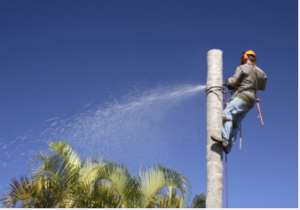Palm tree removal is removing the palm tree from your property. You may want to remove the palm tree in your yard for various reasons. For example, remove the tree if you have a palm tree growing on your property or think it is too close to your home.
Depending on your reason for palm tree removal, it may be a good idea to call a professional palm tree removal company to come to your house and make a free estimate.
Pruning palm trees
Pruning palm trees is a great way to keep them healthy. The best time to prune is during the summer months. You can use a hand pruner or pruning saw to cut the leaves. Avoid cutting the trunk, as this will cause damage.
 A good rule of thumb is to only cut fronds above 9 and 3 o’clock positions. It will avoid the “hurricane cut” look. However, you may need to cut a few fronds at any other time, including the flower stalks.
A good rule of thumb is to only cut fronds above 9 and 3 o’clock positions. It will avoid the “hurricane cut” look. However, you may need to cut a few fronds at any other time, including the flower stalks.
Palms are usually self-cleaning. They naturally drop dead fronds. To maintain a symmetrical tree, you should remove the dead fronds. When you do, make sure you do it carefully.
Dead fronds can be a breeding ground for pests and rodents. They can also block roads and sidewalks. Remove any fronds that are blocking the area.
In addition to removing dead fronds, it is also essential to remove the seed heads. It will keep unwanted seedlings from growing in your landscape. To do this, you should remove the seed heads before they fall.
To protect your palms, you should disinfect any cutting tools used on your trees. Using infected cutters will help spread diseases to the rest of the trees. Also, whenever possible, dispose of any pruning waste properly.
Pruning your palm tree is a complicated process. It requires special equipment and careful consideration. Taking the time to do it right can keep your palms healthy and beautiful. But if you don’t know what you are doing, it can be a dangerous job.
During hurricane season, it’s imperative to prune your palms. It will not only prevent them from blowing over but will also allow them to receive nutrients better. While some might think trimming your palms will reduce their size, it is a great way to increase their growth.
There are many different kinds of palm trees. Some are self-cleaning, while others require regular pruning. Your decision about which type of palm to grow depends on what you want in your landscape.
Detecting signs that a palm tree needs to be removed
When considering removing a palm tree, you must first know what signs to look for. The best way to do that is to ask an expert. A few symptoms include yellowing leaves, rusty stains on the leaf, or black fruiting bodies.
There are also fungal pathogens and bacterial infections. Some of the latter’s symptoms include bud rot, stunted new growth, rot at the tree’s base, iding reinfection, and controlling
Some insects are harmless, while others can be harmful to your palm. For example, insects such as slugs, fungus, and planthoppers can cause damage to your palms. You can treat these pests with a special palm fertiliser. Fortunately, there are many ways to deal with these problems.
One way to treat sooty mould on your palm is to hose off the affected leaves. It should help, but cutting down infected trees may still be necessary.
Another problem is root rot. This disease is caused by too much water or poorly draining soil. Removing a palm tree with this disease is possible, but you need to be careful about getting the roots exposed.
If you are trying to figure out what is wrong with your palm, you can contact a company specialising in palm tree removal. It is safer to do this than to cut it down. These companies will be able to identify the type of tree and determine its value.
When you decide to remove a palm, consider the size of the space. Especially in narrow areas, it will cost more to move a tree than to cut it down. Consider your purpose for removing the tree, too. For example, please do not cut it down near power lines.
Check your local regulations about cutting down tall trees. It is hazardous to do this close to buildings. Before you begin, please take a picture of the tree to see its features.
Make sure you keep the cutting spot safe. Ideally, it would help if you placed the cutting spot far from buildings and power lines.
Using a stump grinder
The palm tree removal stump-grinding craze has come a long way since the heyday of hand sawing. A stump grinder can grind a palm stump into small, neat fragments. It will ensure the tree doesn’t regrow and help keep the area clean and tidy.
Using a stump grinder is the easiest way to remove a palm tree. However, you’ll need to be careful about the safety of your crew. Stump grinding is less potent than other tools, and you should wear the right gear and follow the instructions carefully.
The most important thing to remember is that a stump grinder isn’t a magic bullet for removing a palm tree. Ultimately, you’ll need a sharp hoe, a demo bar, and some elbow grease.
Disposing of the green waste
There is a lot of waste produced by palm fronds. A sustainable solution could be the key to diverting more waste from landfills, ultimately saving local taxpayers money.
The first step in disposing of palm fronds is to cut them into smaller pieces. These smaller pieces can then be composted or recycled. They can also be used as mulch. However, they are not biodegradable, so they must be composted or recycled separately from other yard waste.
To compost palm fronds, you must get an industrial-strength chipper. You can also use a hand-crank grinder to grind the fronds. It will create less-than-perfect mulch, however.
The palm fronds will also need to be mulched to speed up the decomposition process. The fronds will break down into tiny, wiry strands during this process. In addition, you may need to combine the fronds with moisture. Adding more moisture can help to speed up the decomposition process.
If you want to recycle palm fronds, you need to find a company that will accept them. Unfortunately, most green-waste facilities will not take them. For example, the Western Regional Sanitary Landfill only takes tree limbs less than an inch in diameter.
It will take up to 50 years for palm fronds to decompose independently. Although they can be composted, this method will not work well with the fibrous nature of the fronds.
